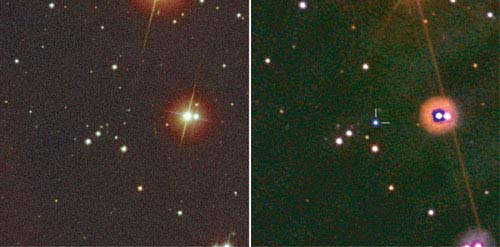NASA Detects 'Totally New' Mystery Explosion Nearby

Astronomers have detected a new type of cosmic outburst that they can't yet explain. The event was very close to our galaxy, they said.
The eruption might portend an even brighter event to come, a supernova.
It was spotted by NASA's Swift telescope and is being monitored by other telescopes around the world as scientists wait to see what will happen.
Neil Gehrels, principal investigator for the Swift mission at NASA's Goddard Space Flight Center, called the event "totally new, totally unexpected."
If the eruption indeed precedes a supernova, then it would reach peak brightness in about a week, scientists said.
| Experienced backyard astronomers can see the explosion with a telescope by using these coordinates: RA: 03:21:39.71 Dec: +16:52:02.6 |
The event, detected Feb. 18, looks something like a gamma-ray burst (GRB), scientists said. But it is much closer-about 440 million light-years away-than others. And it lasted about 33 minutes. Most GRBs are billions of light-years away and last less than a second or just a few seconds.
Other aspects of the newfound eruption were inexplicable, astronomers said. It was dimmer than most. Even so, the newly spotted point of light in the sky outshines the entire galaxy in which the event occurred.
Breaking space news, the latest updates on rocket launches, skywatching events and more!
"This could be a new kind of burst, or we might be seeing a gamma-ray burst from an entirely different angle," said Swift scientist John Nousek at Penn State University.
Astronomers don't fully understand gamma-ray bursts (GRBs). But they theorize that when one is pointed our way, it appears brighter than when the beams it produces shoot off in other directions.
The explosion has been catalogued as GRB 060218. It is the second-closest GRB ever detected. But it's not clear if it will ultimately be called one.
Italian researchers using the European Southern Observatory's Very Large Telescope in Chile found signs in the event's optical afterglow that it may become a supernova. The scenario outlined by some researchers is that a very massive star has collapsed into a black hole and then exploded.
If the event is indeed a supernova in the making, scientists may get the first look at one unfolding from start to finish.
The eruption occurred in the constellation Aries.
- VIDEO: Hypernovas
- Gamma Ray Bursts and Supernovae
- Mysterious High-Energy Bursts Linked to Supernova
- Brightest Galactic Flash Ever Detected Hits Earth
- Creation of Black Hole Detected

Rob has been producing internet content since the mid-1990s. He was a writer, editor and Director of Site Operations at Space.com starting in 1999. He served as Managing Editor of LiveScience since its launch in 2004. He then oversaw news operations for the Space.com's then-parent company TechMediaNetwork's growing suite of technology, science and business news sites. Prior to joining the company, Rob was an editor at The Star-Ledger in New Jersey. He has a journalism degree from Humboldt State University in California, is an author and also writes for Medium.
